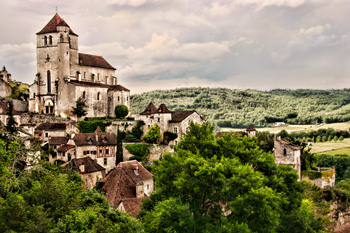
by Karoline Cullen
“I’ll light this candle,” the guide explains, “so you’ll be able to see this as the artist did.” The dim flame wavers as he crouches below a painting and holds the candle close to the wall. In the flickering light, a huge, powerful beast is revealed. A rough curve of rock gives dimension to its rounded haunch. Its nostrils flare and beady eyes stare, its ochre colour as vibrant as the bison itself must have been.
We are in a narrow cave called Font-de-Gaume, near Les Eyzies in the Dordogne Valley of southwest France. This is the cradle of prehistory, where 10,000 to 20,000 years ago Cro-Magnon man celebrated the world around him with cave paintings. Font-de-Gaume is the first of three different caves we visit for a glimpse into the lives of our relatives from distant times.
 On the climb to the entrance of Font-de-Gaume, we are told Cro-Magnon man was not so different from us. If he was in a suit and got on a bus today, you would not think twice about it, the guide delightedly relays. In the cave, one of the last in France with polychrome paintings still open to the public, the guide constantly reminds us to not touch the walls or brush against the paintings. Many have deteriorated with age and some are marred by graffiti. It’s dark and damp but when the lights shine on a frieze, there are audible gasps of appreciation at the vitality, colours, and exactness of scale of the animals. Some outlines are engraved while others make use of the rocks’ curvatures to give depth. Bison, reindeer, mammoths, and little black-brown horses are mixed with a variety of undeciphered symbols. Some figures are static and others portray motion quite effectively. A favourite scene features a long-antlered reindeer licking the head of another kneeling opposite in a moving display of tenderness. After leaving the darkness of Font-de-Gaume, we meander northwards along the Vézère River to Lascaux II, a cave near Montignac.
On the climb to the entrance of Font-de-Gaume, we are told Cro-Magnon man was not so different from us. If he was in a suit and got on a bus today, you would not think twice about it, the guide delightedly relays. In the cave, one of the last in France with polychrome paintings still open to the public, the guide constantly reminds us to not touch the walls or brush against the paintings. Many have deteriorated with age and some are marred by graffiti. It’s dark and damp but when the lights shine on a frieze, there are audible gasps of appreciation at the vitality, colours, and exactness of scale of the animals. Some outlines are engraved while others make use of the rocks’ curvatures to give depth. Bison, reindeer, mammoths, and little black-brown horses are mixed with a variety of undeciphered symbols. Some figures are static and others portray motion quite effectively. A favourite scene features a long-antlered reindeer licking the head of another kneeling opposite in a moving display of tenderness. After leaving the darkness of Font-de-Gaume, we meander northwards along the Vézère River to Lascaux II, a cave near Montignac.
 Grotte de Lascaux’s streams of ochre and black bison careening over its walls are the classics of cave paintings. They are the earliest known examples of representational art at a mind-boggling 17,000 years old. Access to the originals is highly restricted as the cave was closed to the public in 1963 to protect the paintings from further deterioration caused by visitors’ body heat and breathing. The French government built Lascaux II nearby, a precise centimetre-by-centimetre replication of two galleries of the original cave. The public can again browse the tableaux detailing the story of a hunt. In some places, entire sections of the walls and ceiling are teeming with stampedes of stags, horses, ibexes, and long horned bulls. As stunning as the display is, it is difficult to forget we are not in the original and the visit feels somewhat stilted. I want another “real” cave to visit.
Grotte de Lascaux’s streams of ochre and black bison careening over its walls are the classics of cave paintings. They are the earliest known examples of representational art at a mind-boggling 17,000 years old. Access to the originals is highly restricted as the cave was closed to the public in 1963 to protect the paintings from further deterioration caused by visitors’ body heat and breathing. The French government built Lascaux II nearby, a precise centimetre-by-centimetre replication of two galleries of the original cave. The public can again browse the tableaux detailing the story of a hunt. In some places, entire sections of the walls and ceiling are teeming with stampedes of stags, horses, ibexes, and long horned bulls. As stunning as the display is, it is difficult to forget we are not in the original and the visit feels somewhat stilted. I want another “real” cave to visit.
 We head for Grotte du Pech-Merle by the Lot River. Photo 2 On our way south, we pass through towns perched precipitously on hilltops; golden-stoned Turenne and the pilgrimage destination of Rocomadour. Photo 3 & 4 The region is known for truffles and foie gras so food is elevated, as only the French can, to almost impossible culinary standards. Even small country restaurant menus have one or both of those luxurious ingredients prominently featured. Did our prehistoric relatives hunt for truffles to garnish their bison?
We head for Grotte du Pech-Merle by the Lot River. Photo 2 On our way south, we pass through towns perched precipitously on hilltops; golden-stoned Turenne and the pilgrimage destination of Rocomadour. Photo 3 & 4 The region is known for truffles and foie gras so food is elevated, as only the French can, to almost impossible culinary standards. Even small country restaurant menus have one or both of those luxurious ingredients prominently featured. Did our prehistoric relatives hunt for truffles to garnish their bison?
The French prehistorian Abbé Breuil describes Pech-Merle as “the Sistine Chapel of the Lot district, one of the most beautiful monuments in Palaeolithic pictorial art.” The cave’s silence is broken only by the sound of water, whose drips created the sculptural stalactites, stalagmites, and other free form backdrops for the paintings. Friezes of horse, bison and mammoth in black charcoal outlines date from 16,000 years ago and there are some red markings about 20,000 years old. A wonderful painting uses a thin outcropping of rock shaped like a horse’s head to portray a spotted horse with a black mane. Human handprints outlined in black are signatures from another time. It is a visual feast in a series of caverns of surreal rock forms decorated with evocative figures.
The cave paintings provide an ephemeral connection to our prehistoric relatives. Thinking of that bison lit by candlelight in Font-de-Gaume almost makes me scan for thundering herds as I emerge from the cave’s darkness into the sunlight of modern day France.
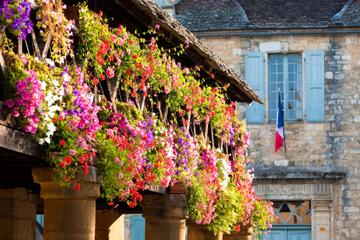
Half day Tour of The Villages of the Dordogne
If You Go:
♦ Reservations at Lascaux and Pech-Merle, particularly in summer, are necessary.
♦ Grotte de Font-de-Gaume, Les Eyzies-de-Tayac, France – eyzies.monuments-nationaux.fr
♦ Lascaux II, Montignac, France – vimeo.com/40849516
♦ Grotte de Pech-Merle, Cabrerets, France – www.pechmerle.com
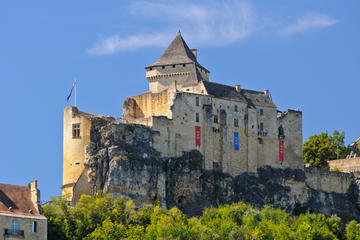
Full Day Tour Dordogne & Vezere Valley
About the author:
Pursuing superb travel experiences to later share in words and photographs keeps Karoline travelling. She is a freelance writer and award winning photographer and regularly contributes articles and photos to a variety of newspapers, magazines, and websites. www.cullenphotos.ca
All photos by Cullen Photos.
Hill town in the Dordogne. [K. Cullen photo]
At Font-de-Gaume entrance. [G. Cullen photo]
Along the Lot River. [K. Cullen photo]
Evening in Rocamadour. [K. Cullen photo]

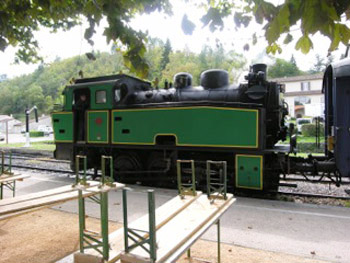
 Our trip began with a short walk from the bus stop at Saint-Jean-du-Gard, treading the bridge over the historic Gardon River, to the the small square abutting the quaint train station. Our locomotive was already huffing and puffing in anticipation; its passengers choosing their carriages with puzzled analysis. Chatter proved easy between travellers and we struck up conversation with a gentleman from a small town in England who popped down to the south for a brief one week junket as he was wont to do on occasion.
Our trip began with a short walk from the bus stop at Saint-Jean-du-Gard, treading the bridge over the historic Gardon River, to the the small square abutting the quaint train station. Our locomotive was already huffing and puffing in anticipation; its passengers choosing their carriages with puzzled analysis. Chatter proved easy between travellers and we struck up conversation with a gentleman from a small town in England who popped down to the south for a brief one week junket as he was wont to do on occasion.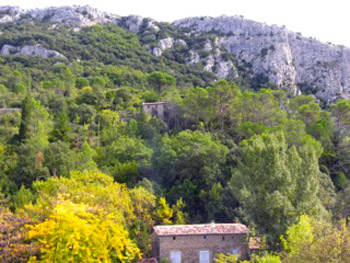 Slowly we ground to a halt for the Bambouseriae (Bamboo Garden) where those wishing to do so disembarked for a tour of this unique jungle that pulls in 150,000 visitors per year. The 10 hectare walk can eat up an hour and half easily so a visit takes some planning and scheduling. Fortunately the return trip comes through two hours later. From our perch high above the park we could espy the tangled canopy and winding trails.
Slowly we ground to a halt for the Bambouseriae (Bamboo Garden) where those wishing to do so disembarked for a tour of this unique jungle that pulls in 150,000 visitors per year. The 10 hectare walk can eat up an hour and half easily so a visit takes some planning and scheduling. Fortunately the return trip comes through two hours later. From our perch high above the park we could espy the tangled canopy and winding trails.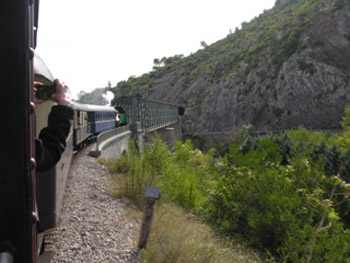 We were catching the bus back to Nimes from Anduze and so had leisurely time to explore this historical gateway to the Cevennes. For those taking the train back they had time for at least a quick stroll about town. Home to a population of 3000, down from its formative years, the Anduze area has evidence of habitation from prehistoric times and was a Gallo-Roman settlement. Here, in the 10th century, the Siegneurie of Anduze was established.
We were catching the bus back to Nimes from Anduze and so had leisurely time to explore this historical gateway to the Cevennes. For those taking the train back they had time for at least a quick stroll about town. Home to a population of 3000, down from its formative years, the Anduze area has evidence of habitation from prehistoric times and was a Gallo-Roman settlement. Here, in the 10th century, the Siegneurie of Anduze was established.
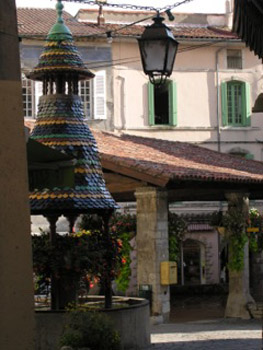 Anduze and its area was long a Protestant holdout during the terrible religious wars of France and suffered for it.
Anduze and its area was long a Protestant holdout during the terrible religious wars of France and suffered for it.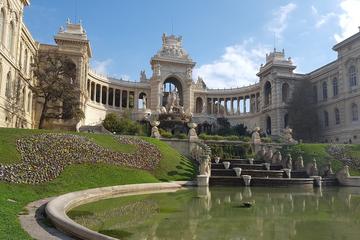
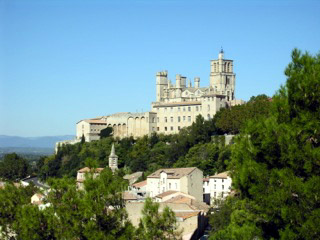
 Beziers is ancient. It has been settled since neolithic times, predating the arrival even of the wide ranging Celts. The Phoenicians are credited as being the first settlers and the city itself takes its inception as 575 BC, only 25 years younger than ancient Marseille. The Romans re founded the city in 36 or 35 BC as a settlement for retired veterans renaming it Colonia Julia Baeterrae Septimanorum. Even the Islamic Moors had a short reign as rulers here from 720 to 752.
Beziers is ancient. It has been settled since neolithic times, predating the arrival even of the wide ranging Celts. The Phoenicians are credited as being the first settlers and the city itself takes its inception as 575 BC, only 25 years younger than ancient Marseille. The Romans re founded the city in 36 or 35 BC as a settlement for retired veterans renaming it Colonia Julia Baeterrae Septimanorum. Even the Islamic Moors had a short reign as rulers here from 720 to 752. With difficulty, amid the winding streets of the old city where we actually came upon a sign pointing in two separate directions to the cathedral, we eventually found ourselves in a shaded square staring high up at the steeple of Saint Nazaire. To say it is awe inspiring is saying the least. It oozed poignancy; I half expected the stone to speak or ghosts to stare down from its heights.
With difficulty, amid the winding streets of the old city where we actually came upon a sign pointing in two separate directions to the cathedral, we eventually found ourselves in a shaded square staring high up at the steeple of Saint Nazaire. To say it is awe inspiring is saying the least. It oozed poignancy; I half expected the stone to speak or ghosts to stare down from its heights.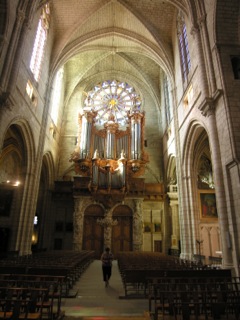 The Albigensian Crusade was initiated by Pope Innocent III, a most ironic title at best, in 1208, against a growing religious splinter group known as the Cathars ( from the Greek Katharos meaning pure). The crusade was to persist until the last of the Cathar “parfaits” was burned at the stake in 1321. What the crusade missed the Inquisition finished. The Cathars, who have been referred to as the Buddhists of Christianity, held there were two gods at play in the world and the world of man was created by the evil god, the satanic god, and the only way to escape was to live a pure life and after several incarnations one would exit the vicious cycle. As part of the purity were such requirements as vegetarianism and celibacy. Of highest esteem were the “parfaits”, those who were most achieved in their quest for heaven.
The Albigensian Crusade was initiated by Pope Innocent III, a most ironic title at best, in 1208, against a growing religious splinter group known as the Cathars ( from the Greek Katharos meaning pure). The crusade was to persist until the last of the Cathar “parfaits” was burned at the stake in 1321. What the crusade missed the Inquisition finished. The Cathars, who have been referred to as the Buddhists of Christianity, held there were two gods at play in the world and the world of man was created by the evil god, the satanic god, and the only way to escape was to live a pure life and after several incarnations one would exit the vicious cycle. As part of the purity were such requirements as vegetarianism and celibacy. Of highest esteem were the “parfaits”, those who were most achieved in their quest for heaven.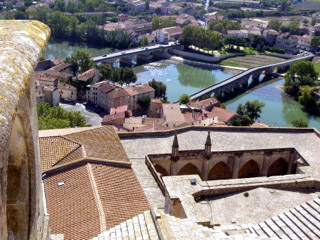 On July 21, 1209 the crusaders appeared at the doorstep of the city and sent word the Catholics could leave and be spared the fate of the resident Cathars. In a remarkable display of loyalty the Catholics chose to stay with their friends and neighbours. The forces of the Crusaders quickly overran the defences and fell upon the inhabitants like wolves. None, neither man woman nor child, Catholic or Cathar, were spared.
On July 21, 1209 the crusaders appeared at the doorstep of the city and sent word the Catholics could leave and be spared the fate of the resident Cathars. In a remarkable display of loyalty the Catholics chose to stay with their friends and neighbours. The forces of the Crusaders quickly overran the defences and fell upon the inhabitants like wolves. None, neither man woman nor child, Catholic or Cathar, were spared.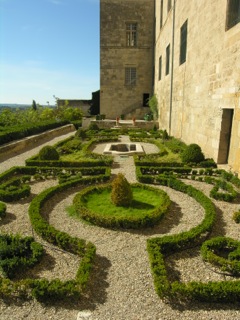 Clambering down we emerged at the square below the heavenly directed spire. An emblazoned plaque sits as a silent reminder of the dark deeds of so many years ago. To be remembered. That is good.
Clambering down we emerged at the square below the heavenly directed spire. An emblazoned plaque sits as a silent reminder of the dark deeds of so many years ago. To be remembered. That is good.
 The cheery pedestrian ways, squares and cafe’s brought us back to the present and the witnessing of the fact life goes on. And under the Sun of southern France colour and liveliness are even more rampant. Beziers is like its urban kin throughout southern France. It is beautiful and a treat to explore.
The cheery pedestrian ways, squares and cafe’s brought us back to the present and the witnessing of the fact life goes on. And under the Sun of southern France colour and liveliness are even more rampant. Beziers is like its urban kin throughout southern France. It is beautiful and a treat to explore.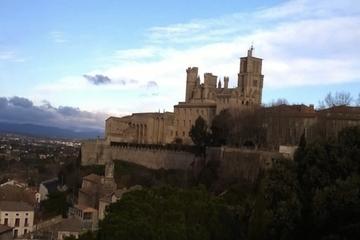

 There is no better place to begin your exploration of this, too seemingly real, walled city. Here beneath the gaze of a serene statue of Saint Louis, actually King Louis IX of France, the city’s ascribed founder, you can sit under the shade of Plantain trees at one of the many outdoor cafes and ponder over the self-guided walking tour pamphlets available at the bordering tourist information centre.
There is no better place to begin your exploration of this, too seemingly real, walled city. Here beneath the gaze of a serene statue of Saint Louis, actually King Louis IX of France, the city’s ascribed founder, you can sit under the shade of Plantain trees at one of the many outdoor cafes and ponder over the self-guided walking tour pamphlets available at the bordering tourist information centre.
 In 1270 Louis once again led his crusader forces from Aigues Mortes reputedly taking service at the still standing Notre Dame de Sablon (Our Lady of the Sands), alongside Place Saint Louis, ere departing. It was his last foray as he died within months from typhus on the shores of North Africa. His new city however fared much better.
In 1270 Louis once again led his crusader forces from Aigues Mortes reputedly taking service at the still standing Notre Dame de Sablon (Our Lady of the Sands), alongside Place Saint Louis, ere departing. It was his last foray as he died within months from typhus on the shores of North Africa. His new city however fared much better. Visit La Chapelle des Penitents Gris (Grey) [TOP PHOTO] and La Chapelle des Penitents Blanc (White); ancient orders rooted in Christianity’s dim past. Their simplistic exteriors belie the more ornamental interiors.
Visit La Chapelle des Penitents Gris (Grey) [TOP PHOTO] and La Chapelle des Penitents Blanc (White); ancient orders rooted in Christianity’s dim past. Their simplistic exteriors belie the more ornamental interiors. Crossing the only bridge spanning the moat surrounding La Tour de Constance brings you to the awe inspiring edifice which harkens back to the very beginnings of the Aigue Mortes fortress town. With the revocation of the Treaty of Nantes (a tolerance act allowing for French Protestants) in 1685 the tower began its long years as a prison. Exploring its bright rooms and walkways it takes some effort to recreate in mind the jailhouse conditions of so many years before. The tower rises above the rampart walls and is topped by an rooftop adorned with a beacon which once served the mariners as a lighthouse. From here you can see the encircled city in its entirety. Here, above the world, its long gone sentries could breath the light Mediterranean air likely much appreciated during odour rich Medieval era.
Crossing the only bridge spanning the moat surrounding La Tour de Constance brings you to the awe inspiring edifice which harkens back to the very beginnings of the Aigue Mortes fortress town. With the revocation of the Treaty of Nantes (a tolerance act allowing for French Protestants) in 1685 the tower began its long years as a prison. Exploring its bright rooms and walkways it takes some effort to recreate in mind the jailhouse conditions of so many years before. The tower rises above the rampart walls and is topped by an rooftop adorned with a beacon which once served the mariners as a lighthouse. From here you can see the encircled city in its entirety. Here, above the world, its long gone sentries could breath the light Mediterranean air likely much appreciated during odour rich Medieval era.

 My wife and I are on a Mediterranean cruise along the coasts of Italy and France celebrating our 20th anniversary, sailing on the ultra-deluxe Norwegian ship. Sea Dream I, which carries just over 100 passengers. Sea Dream I is a magic carpet, easing us in comfort and style through a region full of fascinating history. We have been anticipating visits to some wonderful ports and are not disappointed. What we had not foreseen, though, is the many ways that Napoleon, or perhaps just his spirit, would keep making his presence felt, as if popping up unexpectedly in little cameo appearances. These underscore just how completely he dominated Europe in his brief but dramatic era of war and conquest, supreme glory and abject defeat.
My wife and I are on a Mediterranean cruise along the coasts of Italy and France celebrating our 20th anniversary, sailing on the ultra-deluxe Norwegian ship. Sea Dream I, which carries just over 100 passengers. Sea Dream I is a magic carpet, easing us in comfort and style through a region full of fascinating history. We have been anticipating visits to some wonderful ports and are not disappointed. What we had not foreseen, though, is the many ways that Napoleon, or perhaps just his spirit, would keep making his presence felt, as if popping up unexpectedly in little cameo appearances. These underscore just how completely he dominated Europe in his brief but dramatic era of war and conquest, supreme glory and abject defeat. The next planned destination is the Italian island of Elba, the one place where we would expect to find sites intimately linked to Napoleon’s life. It was on Elba that he was forced into exile (along with about 1000 servants and troops as bodyguards) after a series of defeats in 1814.
The next planned destination is the Italian island of Elba, the one place where we would expect to find sites intimately linked to Napoleon’s life. It was on Elba that he was forced into exile (along with about 1000 servants and troops as bodyguards) after a series of defeats in 1814. Then we anchor off Viareggio, back on the Italian coast in Tuscany, and take a day trip inland to Florence. We have arranged a walking tour to enjoy the glorious and stunning medieval and Renaissance architecture, monumental public sculptures and inviting pedestrian-only piazzas. It is far too brief, of course, but our personal guide takes us to some special places, such as the studio of a blacksmith who creates fantastic birds, fishes and other creatures in steel, and to the guide’s own favourite and funky “Cafe of the Artisans.” We stroke the snout of an iconic bronze wild boar and share a kiss, thus assuring our return to Florence some day.
Then we anchor off Viareggio, back on the Italian coast in Tuscany, and take a day trip inland to Florence. We have arranged a walking tour to enjoy the glorious and stunning medieval and Renaissance architecture, monumental public sculptures and inviting pedestrian-only piazzas. It is far too brief, of course, but our personal guide takes us to some special places, such as the studio of a blacksmith who creates fantastic birds, fishes and other creatures in steel, and to the guide’s own favourite and funky “Cafe of the Artisans.” We stroke the snout of an iconic bronze wild boar and share a kiss, thus assuring our return to Florence some day. Farther north on the Italian Riviera, our ship anchors off the picturesque village of Portofino, with its brightly painted old houses. Once a simple fishing village, it now has an upscale yacht harbour catering to the rich and famous. Going ashore for a few hours, we hike up to a striking castle that dominates the small bay. And sure enough, Napoleon left his mark here as well during the years when France controlled northern Italy. What we see is an ancient fortification that Napoleon modernized, greatly expanded and equipped with better cannons. Not one for modesty, he renamed the village Port Napoleon.
Farther north on the Italian Riviera, our ship anchors off the picturesque village of Portofino, with its brightly painted old houses. Once a simple fishing village, it now has an upscale yacht harbour catering to the rich and famous. Going ashore for a few hours, we hike up to a striking castle that dominates the small bay. And sure enough, Napoleon left his mark here as well during the years when France controlled northern Italy. What we see is an ancient fortification that Napoleon modernized, greatly expanded and equipped with better cannons. Not one for modesty, he renamed the village Port Napoleon. While a student, I had bunked at a unique youth hostel in a little modern castle overlooking Finale Ligure, a lovely stretch of coastal villages on the Italian Riviera only an hour east of Monaco. We decide to return to explore those intriguing shores, with their rich and diverse history. It was here that the 15-year-old Margaret Theresa of Spain stopped briefly in 1666 while on her way to Vienna to marry Leopold I, the Holy Roman Emperor. A triumphal arch commemorating the event dominates the central piazza, not far from ancient fortifications that marked the long-fought-over boundary between Spanish and Genoese-controlled territories. A few miles east is the village of Varigotti with its strikingly Moorish houses. These were built in the ninth and tenth centuries by the Muslim Saracens, who ruled the area for nearly 100 years. Long thereafter, they remained both a threat and a trading partner to the region, bringing such goods as salt from Ibiza when Spain was still under Moorish rule.
While a student, I had bunked at a unique youth hostel in a little modern castle overlooking Finale Ligure, a lovely stretch of coastal villages on the Italian Riviera only an hour east of Monaco. We decide to return to explore those intriguing shores, with their rich and diverse history. It was here that the 15-year-old Margaret Theresa of Spain stopped briefly in 1666 while on her way to Vienna to marry Leopold I, the Holy Roman Emperor. A triumphal arch commemorating the event dominates the central piazza, not far from ancient fortifications that marked the long-fought-over boundary between Spanish and Genoese-controlled territories. A few miles east is the village of Varigotti with its strikingly Moorish houses. These were built in the ninth and tenth centuries by the Muslim Saracens, who ruled the area for nearly 100 years. Long thereafter, they remained both a threat and a trading partner to the region, bringing such goods as salt from Ibiza when Spain was still under Moorish rule.



